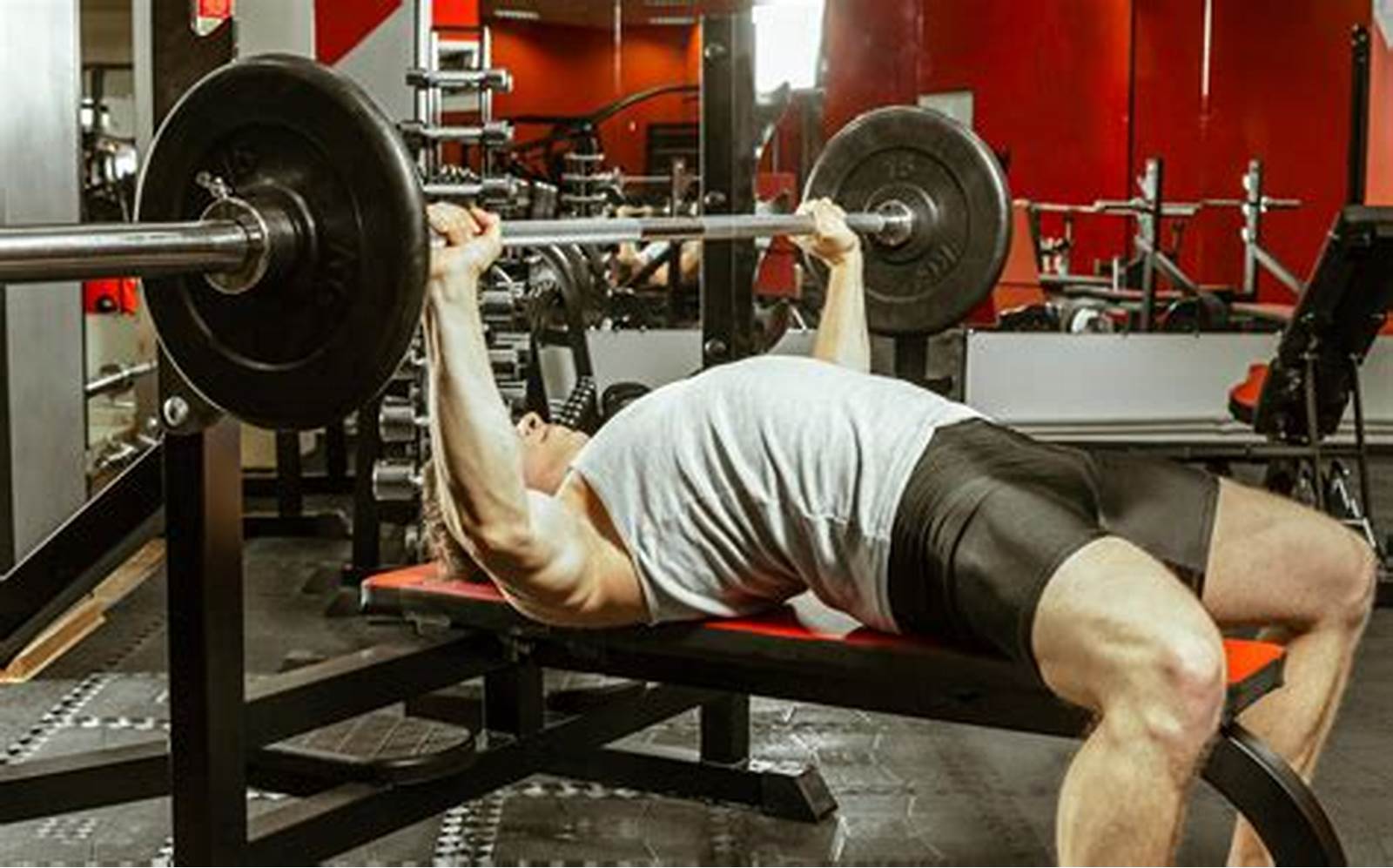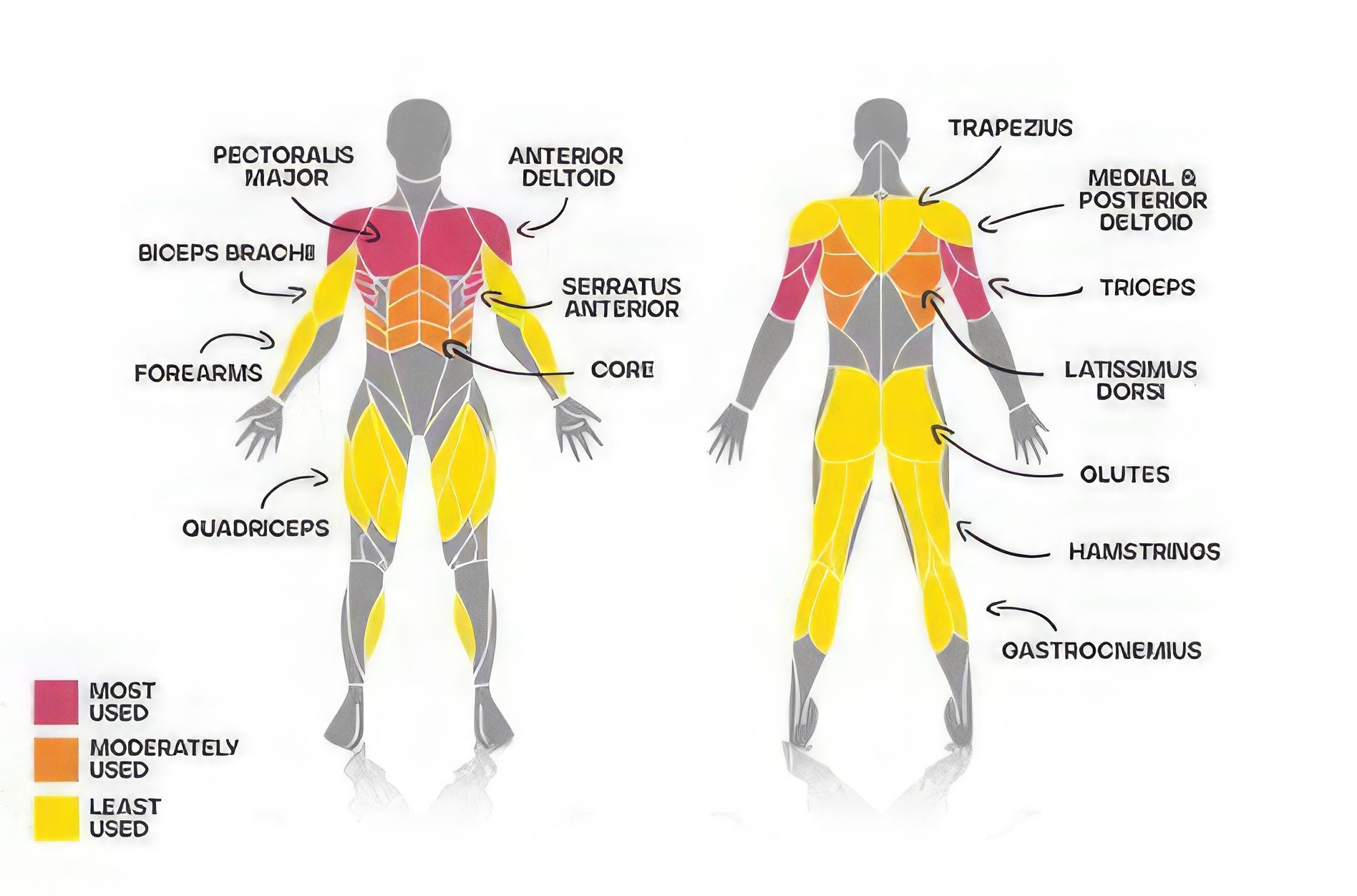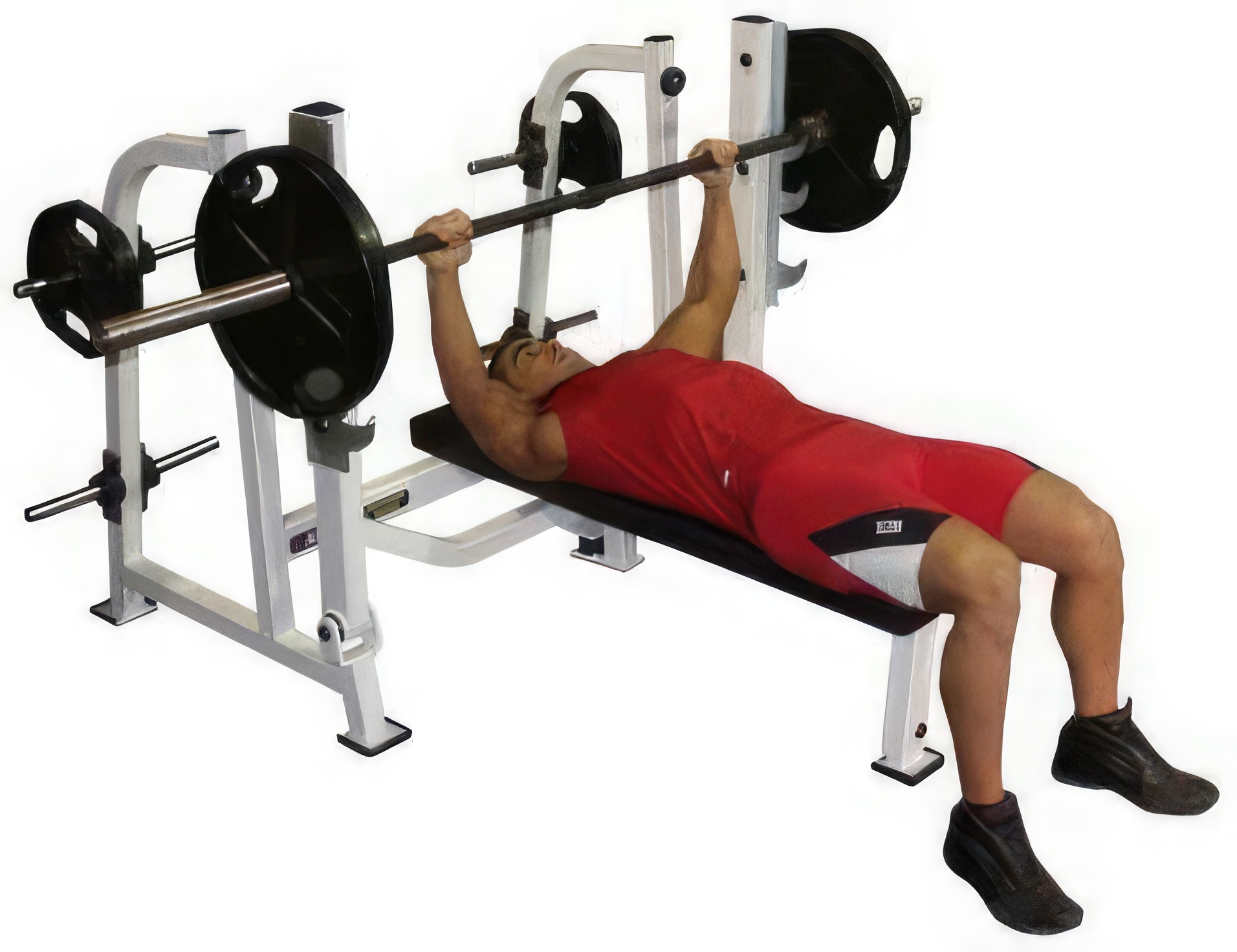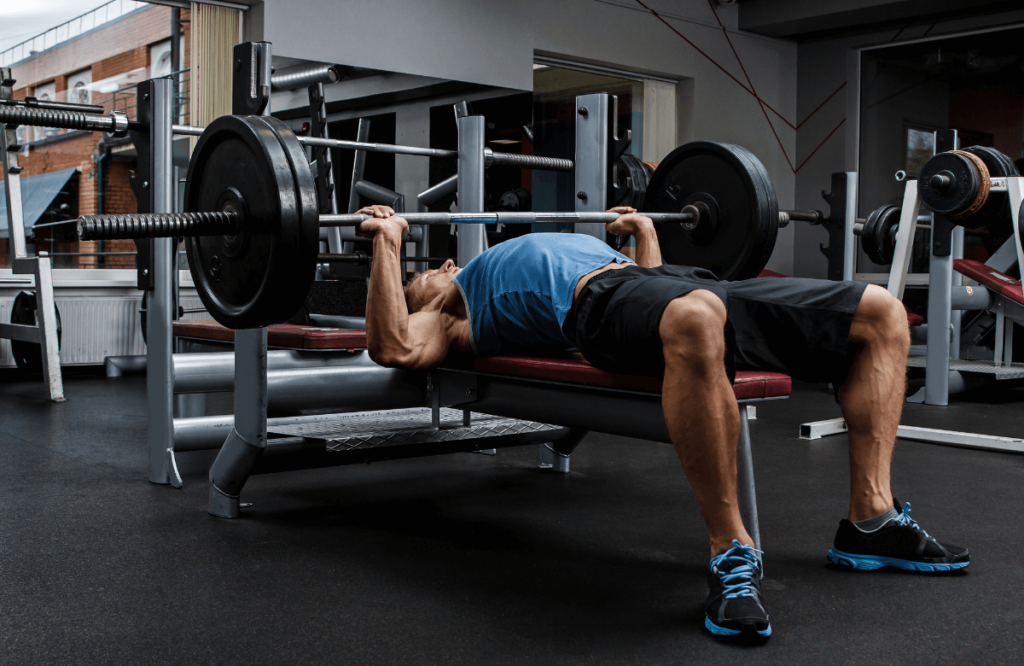
What does bench press work is using the upper body by combining basic exercises to train muscle strength. This exercise involves lying on a flat bench and pressing a barbell or weighted dumbbell upward until the arms are fully extended, then lowering them back to the chest in a controlled manner. The bench press is widely used by athletes, bodybuilders, and fitness enthusiasts to build strength and muscle mass in the chest, shoulders, and triceps.
Muscles Worked When Doing Bench Press

The bench press is a comprehensive exercise that involves several major muscle groups:
- Pectoralis Major (Large Chest Muscle)
This is the main muscle worked when doing the bench press. The pushing movement helps develop the size and strength of the chest muscles.
- Anterior Deltoid (Front Shoulder Muscle)
Acts as a supporting muscle that helps lift the weight upward.
- Triceps Brachii (Back Arm Muscle)
Responsible for the elbow extension process, which helps push the barbell up.
- Latissimus Dorsi (Wide Back Muscle)
Although not the main muscle, the latissimus dorsi helps in stabilizing the movement.
- Core (Core Muscle)
The abdominal and lower back muscles help stabilize the body during bench press exercises.
Benefits of Bench Press

After knowing what does bench press work is not only about forming a strong upper body, but bench press also has various other benefits. Here are some of the main benefits of bench press exercises:
1. Increase Upper Body Strength
The bench press trains the strength of the chest, shoulder, and arm muscles. With consistent training, a person can increase pushing strength which is useful in various physical activities.
2. Increase Muscle Mass
What does bench press work on is very effective for muscle hypertrophy or increasing muscle mass. With enough weight and the right training pattern, the muscles involved in the bench press will grow bigger and stronger.
3. Improves Athletic Performance
Many athletes, especially in sports that require upper body strength such as boxing, rugby, and basketball, rely on the bench press to increase their strength on the field.
4. Increases Bone Density
Weight training such as the bench press helps increase bone density, reducing the risk of osteoporosis, especially for people who age.
5. Helps Muscle Stability and Balance
The bench press exercises train coordination and balance between the muscles of the upper body. This is important for maintaining posture and preventing injury.
6. Increases Explosive Power and Functional Strength
The bench press movement trains muscle explosive power, which is useful in various physical activities, such as pushing heavy objects or performing explosive movements in sports.
Bench Press Exercise Variations

Several bench press variations can help target the muscles in different ways. What does bench press work with its exercise variations?
1. Flat Bench Press
A standard variation that targets the middle chest muscles. Used by powerlifters and bodybuilders to increase the strength and mass of the chest muscles.
2. Incline Bench Press
Incline the bench up about 30-45 degrees. This exercise aims to target the upper chest muscles and the front shoulder muscles.
3. Decline Bench Press
Incline the bench down about 15-30 degrees. Targets the lower chest muscles and takes pressure off the shoulders.
4. Dumbbell Bench Press
Uses dumbbells instead of a barbell. Allows for a greater range of motion and increases stabilizer muscle activation.
5. Floor Press
Performed without a bench, with the body lying on the floor. Reduces pressure on the shoulders and focuses on triceps strength.
Correct Bench Press Technique for Maximum Results and Preventing Injury
What does bench press work must be done with the correct technique. If done correctly, this exercise can increase strength, build muscle, and reduce the risk of injury. Here is a complete guide to the correct bench press technique.
1. Body Position Before Lifting
Before starting to lift weights, it is important to prepare for an optimal body position.
A. Foot Placement
- Make sure your feet are flat on the floor, slightly wider than your hips.
- Do not lift your heels or move your feet during the exercise.
- Push your feet onto the floor to help maintain body stability and increase leg drive.
B. Back Position
- Arch your lower back slightly, but not too much.
- Make sure your buttocks remain in contact with the bench during the exercise.
- The arch of the back helps create stability and allows the chest muscles to work more optimally.
C. Shoulder Placement
- Pull your shoulders back and down (scapular retraction) to reduce pressure on the shoulder joints.
- This technique helps activate the upper back muscles and keeps the chest high.
D. Hand Grip on the Barbell
- Position your body with the barbell wider than shoulder width
- Use a firm grip and make sure your wrists are parallel to your forearms.
- Do not use a “thumbless grip” (monkey paw), as it can increase the risk of the barbell slipping from your hands.
2. Lowering the Barbell (Eccentric Phase)
This movement must be fully controlled to avoid injury and maximize muscle activation. What does bench press work namely:
- Take a deep breath before lowering the barbell.
- Slowly lower the barbell towards your chest with your elbows forming an angle of about 75-90 degrees.
- Make sure the barbell touches the middle of your chest (sternum), not your neck or stomach.
- Do not let the barbell bounce off your chest, this can reduce the effectiveness of the exercise and risk injury.
3. Upward Barbell Pushing Movement (Concentric Phase)
Once the barbell reaches your chest, push it back up with full force.
- Make sure your elbows remain slightly bent at the top to reduce stress on your joints.
- Use your legs to push into the floor and add leg drive.
- Do not let the barbell sway or become uncontrolled during the upward movement.
4. Key to Correct Breathing Technique
Breathing plays a major role in maintaining stability and increasing strength when doing bench presses. What does bench press work with the correct breathing technique, namely:
- Take a deep breath before lowering the barbell to increase intra-abdominal pressure and maintain core stability.
- Hold your breath during the eccentric (down) phase, then exhale as you push the barbell up.
- Do not hold your breath for too long as it can cause dizziness or loss of balance.
5. Using “Leg Drive” for Stability and Strength
Leg drive is a technique used by powerlifters to increase strength when doing bench presses.
- When starting to push the barbell up, push your feet onto the floor as if you want to slide the bench back.
- This technique helps channel power from the lower body to the upper body.
- Good leg drive helps maintain stability and allows for heavier lifting.
Tips for Making Bench Press a Routine Exercise, Especially for Beginners
What does bench press work is one of the best exercises for building strength and muscle mass in the upper body. However, for beginners, this exercise can be challenging because it requires correct technique and consistency. For bench press to be an effective and safe exercise routine, here are some important tips that can be applied:
1. Start with Light Weights and Focus on Technique
Many beginners are tempted to immediately lift heavy weights, but this can increase the risk of injury and make the exercise feel difficult. What does bench press work for beginners, you can use light weights or an empty barbell if you are trying it for the first time.
2. Create a Consistent Training Schedule
For bench press to be part of your exercise routine, it is important to have a regular schedule. You can do bench presses a lot 2 to 3 times a week, the goal is so that the muscles can have time to develop.
3. Increase Load Gradually (Progressive Overload)
To increase strength and muscle mass, it is important to increase load gradually. Add about 1.5-5 kg of load each week if possible.
4. Pay Attention to Diet and Protein Intake
Training without good nutrition will not give maximum results. Consume enough protein and calories for muscle recovery and building muscle mass.
5. Warm Up Before Bench Press
This exercise emphasize warming up because it can reduce the risk of injury and improve training performance. Do a dynamic warm-up for 5-10 minutes (jumping jacks, arm circles, light push-ups).
The bench press is an exercise that looks simple but requires proper technique to be effective and safe. I highly recommend that beginners do not use too much weight, and do not be obsessive about the weight, what should be emphasized is preventing injury and correct technique. As a professional, I accompany many beginners who want to do bench presses with the right technique and minimize injury with routine training and proper guidance to increase the load.
What does bench press work start from breathing, correct technique, and exercise variations to a routine schedule. Bench press has many benefits, especially for increasing muscle mass, athletic performance, and functional strength. For best results, be sure to warm up, maintain proper technique, and gradually increase the weight according to your ability.
FAQs
What muscles does the bench press work?
The bench press targets the chest, shoulders, and triceps. It also engages the core and back for stability.
Is the bench press good for building muscle?
Yes! Bench press is one of the best exercises for increasing upper body strength and muscle mass.
Can bench press help with weight loss?
While it mainly builds muscle, it also boosts metabolism, helping with fat loss.
How often should I bench press?
2-3 times per week is ideal for strength and growth.
Should beginners start with dumbbells?
Yes, dumbbells help improve balance and form before moving to a barbell.

Guntur is a bodybuilding and powerlifting enthusiast. He is also the main author of this blog https://learn-bodybuilding.com/
Guntur also works as a Personal Trainer in his town.
In his free time, he likes to learn new languages and reading.
You can contact him from this website’s Contact Page.